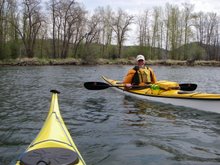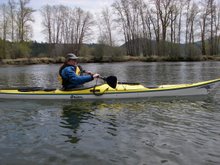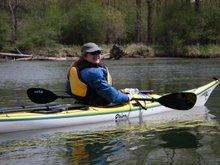HYPOTHERMIA
Hypothermia is the single greatest threat to Sea Kayakers. It can occur quickly and it can be fatal. The average adult has 50-50 chance of surviving a 50-yard swim in 50 degree water. You lose body heat 25 times faster in the water than in air! Swimming increases heat loss. Don't wear cotton Wet cotton chills. Wear a wetsuit (drysuit if conditions warrant) and fabrics that wick water away from your body. Carry dry clothes & a windbreaker protected in a dry bag. The air warms up long before the water. New England's coastal waters and large lakes ALWAYS demand respect, in SUMMER TOO!.
Hypothermia occurs when the body's core temperature falls below its normal level of 98.6°F to 95°F or cooler. It is the opposite of fever, when the body's temperature is above normal.
Hypothermia is dangerous because it affects the body's core - the brain, heart, lungs, and other vital organs. Even a mild case of hypothermia affects your physical and mental abilities, and increases the risk of accidents. Severe hypothermia causes loss of consciousness and may result in death.
Cold water is especially dangerous because loss of body heat occurs 25 times faster in cold water than in cold air. How quickly you become hypothermic depends on many factors, including your behavior, environmental factors, how you are dressed, and your physical condition.
Everyone reacts differently to the cold, even under the same conditions. Generally, children lose body heat more quickly than adults. Thin people lose body heat faster than overweight people. The expected survival times in Table 1 are guidelines for the average adult, showing the rapid onset of hypothermia as water temperatures drop.
TABLE 1Cold Water TemperaturesDecrease Time Before Exhaustion andDecrease Survival Time
WaterTemperature (°F)
Expected TimeBefore Exhaustion or Unconsciousness
Expected Timeof Survival
32.5
Under 15 minutes
45 minutes
32.5-40
15-30 minutes
30-90 minutes
40-50
30-60 minutes
1-3 hours
50-60
1-2 hours
1-6 hours
60-70
2-7 hours
2-40 hours
70-80
3-12 hours
3 hours to indefinite
Over 80
Indefinite
Indefinite
SYMPTOMS OF HYPOTHERMIAWhen you first fall into cold water you gasp, your skin begins to cool, and your body constricts surface blood vessels to conserve heat for your vital organs. Blood pressure and heart rate increase. Muscles tense and shiver; this produces more body heat, but results in a loss of dexterity and motor control. As your body's core temperature drops further, blood pressure, pulse, and respiration rates all decrease.
As conditions worsen, your mental attitude and level of consciousness change. Resisting help and acting irrational or confused are common indicators of hypothermia. As your core temperature drops dangerously low (from 90°F to 82°F), you become semiconscious, then unconscious. Stress, shock, and low core temperatures may cause cardiac and respiratory failure.
Hypothermia symptoms intensify as your core temperature drops. Since each individual reacts differently, the severity of hypothermia is best measured by taking a core temperature reading using a rectal thermometer. Oral measurements do not accurately measure changes in the core temperature.
HYPOTHERMIA AND THE DIVING REFLEXWhen a person's face comes into sudden contact with very cold water, the "mammalian diving reflex" may be triggered. This lowers the heart rate, increases blood pressure, shuts down blood circulation to all but the body's core. The result is a lowered metabolism, so the body can conserve oxygen. This may help survival in cold water, since oxygen in the blood is carried to the brain and vital organs where it is needed most.
As a result of the dive reflex, people submerged for more than four minutes (when brain damage usually occurs) have been successfully resuscitated. The chances for surviving such a near-drowning depend on water temperature (colder is better), length of time under water, age of the person (younger is better), and rescue efforts.
The dive reflex and hypothermia can lead to fatal cardiac or respiratory arrest. Survival depends on prompt first aid and medical assistance. Cold water near-drowning victims have been revived after as long as one hour under water. Professional medical care is needed to resuscitate these victims, but rescuers should not give up on victims of extended cold water submersion.
Persistence in first aid and rescue efforts is also critical for cold air hypothermia victims. According to hypothermia researcher Dr. Larry Wittmers, "You aren't dead until you're warm and dead."
FIRST AIDMinimize the victim's physical exertion when removing her or him from cold water. Rescuers may have to enter the water to get the victim. Once out of the water, gently remove wet clothing and cover the person with dry clothing or blankets. Protect the victim from wind, especially around the head and neck. Get her or him into a warm environment promptly and avoid re-exposure to the cold.
Choose first aid methods based on the severity of hypothermia symptoms and the field conditions. Decide if artificial respiration or cardio-pulmonary resuscitation (CPR) is needed, assess the severity of the hypothermia, and re-warm the victim.
During all first aid efforts, watch for changes in the victim's temperature and vital signs. "After drop" is a danger when re-warming hypothermia victims because cold blood in the extremities returns to the body core, lowering the core temperature further. See Table 2 for techniques to minimize the effects of "after drop." These general procedures assume a rescuer has no special medical training or equipment, will prevent further heat loss, and will get professional medical help for the victim as soon as possible.
TABLE 2HYPOTHERMIA SYMPTOMS(Body Core Temperature)
Mild Symptoms(97-93°F, 36-34°C)
Shivering, with cold hands and feet
Still alert and able to help self
Numbness in limbs, and loss of dexterity, clumsiness
Pain from cold
Mild Cases
Primary task is to prevent further heat loss and allow body to re-warm itself
Give warm, sweet drinks - no alcohol
Apply gentle heat source to stabilize temperature
Help victim exercise to generate heat
Keep victim warm for several hours, with head and neck covered
Moderate Symptoms(93-90°F, 34-32°C)
Shivering may decrease or stop
Moderate Case
Same as above
Limit exercise
Offer sips of warm, sweet liquids only after victim is fully conscious, begins to re-warm, and is able to swallow - no alcohol
Severe Symptoms(90-82°F, 32-28°C)
Shivering decreases or stops
Confusion, abnormal behavior, i.e, loss of reasoning and recall
Victim appears drunk; very clumsy, slurs speech, denies problem and may resist help
Victim is semiconscious to unconscious
Muscular rigidity increases
Severe Cases
Obtain medical advice as soon as possible, using your radio if necessary
Assist but avoid jarring victim - rough handling may cause cardiac arrest or ventricular fibrillation of heart
No food or drink - no alcohol
Ignore pleas of "Leave me alone, I'm OK." Victim is in serious trouble - keep a continuous watch
Treat as for shock - lay down in bunk, wedge in place, elevate feet
Apply external mild heat to head, neck, chest, and groin - keep temperature from dropping, but avoid too rapid a temperature rise
Transport gently and quickly to hospital
Critical Symptoms(82°F, 28°C or below)
Unconscious, may appear dead
Little or no apparent breathing
Pulse slow and weak, or no pulse found
Skin cold, may be bluish-gray color
Pupils may be dilated
Body is very rigid
Critical Cases
Always assume patient is revivable; don't give up
Handle with extreme care
Tilt the head back to open the airway - look, listen and feel for breathing and pulse for one to two full minutes
If there is any breathing or pulse no matter how faint or slow, do not give CPR, but keep a close watch for changes in vital signs
Stabilize temperature with external heat sources; also use naked chest-to-back warming by others (leave legs alone), and/or use rescuer's breath exhaled in victim's face in unison with victim's breathing
If no breathing or pulse is detected for one to two minutes, begin CPR immediately. Medical help is imperative - hospitalization is needed
To re-warm hypothermia victims in the field:- Use the body heat of a rescuer through maximum direct body contact. Both rescuer and victim should remove outer clothing and be wrapped in a dry sleeping bag or blanket to conserve body warmth. It is best to place the victim between two rescuers.- Apply hot water bottles or hot, wet cloths to the victim's head, neck, trunk, and groin. Change the water periodically to ensure a constant temperature. The water should be 110-115°F to prevent burning.- Exhale into the victim's face as s/he inhales.
Two additional re-warming methods require more equipment than usually available in field situations. These are best left to trained medical personnel: (1) administer heated, humidified oxygen to the victim at a temperature of 102-112°F, (2) provide a warm bath of 100-115°F water. Immerse the victim's trunk but keep the arms and legs out of the water. These methods should be used only on people without major injuries, who do not need resuscitation, and who have been hypothermic for less than 12 hours.
Hypothermia victims with moderate to critical symptoms should always be treated by medical professionals as soon as possible. After medical treatment, victims should be protected from the cold and kept warm.
HYPOTHERMIA PREVENTION: METHODS AND EQUIPMENTConserving body heat is essential for survival and for increasing your chances of being rescued. The rate at which a body cools varies with body size, age, gender, water and air temperature, waves, wind, water currents, and other factors. See Table 3 for examples of how different situations affect survival time for an average sized, lightly clothed adult in 50°F water. Four important prevention principles are illustrated.
TABLE 3Hypothermia Prevention Methods and Equipment Increase Survival Time
Situation AND Predicted Survival Time
(Hours) in 50°F Water
Without flotation device worn
Drown Proofing
1.5
Treading Water
2
With personal flotation device (e.g., vest or collar-type PFD)
Swimming
2
Holding Still
2.7
H.E.L.P. Position
4
Huddling with Others
4
With hypothermia prevention Equipment
Insulated Flotation Jacket (float coat)
3 to 9
Survival Suit
Indefinite
FirstThe more body area you keep out of the water, the better your chances for survival. The drown proofing technique of repeatedly lowering your head into the water and floating causes substantial heat loss, and is not recommended in cold water. If you have no personal floatation device and nothing to climb onto, tread water. If possible, climb onto your capsized boat or pull yourself out of the water onto floating object to increase your chances of survival.
SecondThe more energy you use in cold water, the more your body cools off. To minimize your heat loss, use a personal flotation device and do not swim unless shore, a life raft, or an overturned boat is nearby. Swimming decreases survival time, and attempting to swim more than three-quarters of a mile accelerates heat loss and hypothermia. Remaining still in the water increases your survival time.
ThirdIf you cannot climb out of the water, conserve body heat by remaining as still as possible and reducing the amount of your body exposed to the water. Protect your critical heat loss regions: the head, sides, armpits, and groin.
The Heat Escape Lessening Posture (H.E.L.P.) can be used only if you are wearing a personal flotation device (PFD). Hold your arms tightly against your sides and across your chest, pull your legs together and up toward your chest. The H.E.L.P. position can be difficult to maintain due to wave conditions, PFD design, and body size. A group of two or more people wearing PFDs can huddle together to conserve body heat, offer moral support, and provide a larger target for rescuers.
FourthFor the greatest protection against hypothermia, insulate the critical regions of your body with specifically designed PFD. A vest PFD offers more protection than a collar-type, and will improve your chances of survival. Insulated flotation jackets protect more of your body than vest or collar-type PFDs. A hood protects the head and neck area, and a removable seat panel reduces heat loss in the groin area. Clothing made of modern water-tight materials like nylon and Gore-Tex help keep warm in and cold water out. While these water-tight fabrics decrease contact with cold water, they require carefully selected underclothing since the garments may not have built-in insulation. If flotation materials are not used, then a PFD must be worn in addition to water-tight clothes.
Regardless of what you use to prevent hypothermia - life vest, float coat, industrial work suit, survival suit, or drysuit - flotation and insulation are important in increasing your survival time. PFDs designed to prevent hypothermia are recommended for anyone who spends time on or near cold water. To increase your visibility in the water, add reflective tape to your PFD. A strobe light, whistle, VHF Radio, or emergency position indicating radio beacon (EPIRB) will increase your chance of being rescued.
The source of this information was found at the Minnesota Sea Grant website in an article by Chad P. Dawson
Subscribe to:
Post Comments (Atom)









No comments:
Post a Comment